
The new Robertson Library building allowed collections previously separated in various locations on and off campus to be brought together under one roof. Prior to 1972, the embryonic library collections and operations were continually on the move, surviving in a number of temporary and scattered locations on campus. The collection at that time comprised the collections inherited from Perth Technical College as well as thousands of newly acquired books, journal titles and other resources.
Although Robertson Library was intended to be the single centralised repository for the collections on campus, the Library soon found itself managing branch libraries at Kalgoorlie, Northam and Shenton Park which had their own special collections: the Western Australian School of Mines (originally opened in 1902), the Muresk Agricultural College (dating from 1926) and Schools of Physiotherapy and Occupational Therapy in operation since the 1950s at Shenton Park.
External Collection
Early on, the Library set up an External Collection within Robertson Library to support students located in regional Western Australia, in conjunction with the establishment of the Institute's new External Studies Unit.
By 1971, there were 605 external students and the Library was posting resources to locations around the state, including the northwest of Western Australia and the Bunbury region.
Curriculum Resource Centre
When WAIT set up a Faculty of Education in 1973, the Library agreed to establish the Curriculum Resource Centre specifically to provide materials for use by education students in practice teaching sessions. This was a unique departure from the Library and the Institute's usual approach which was not to support department specific collections on the Bentley campus.
In 1975, with the absorption of the Kindergarten Teachers' College collection, the Resource Centre opened in the new School of Teacher Education building.
A bonanza for collection growth – the 1973 Commonwealth Grant
In the early years of WAIT, the Library’s acquisitions budget for books and journals was modest, starting at just $35 000 in 1968 and growing to $160 000 in 1973.
Gaining sufficient funds to provide an adequate collection was a major concern.12 So it was a huge boost to collection growth when, in 1973, the newly elected Whitlam Labor Government provided $5 million in unmatched grants to College of Advanced Education (CAE) libraries to improve their collections.13 Principal Librarian Geoffrey Allen played a key role in lobbying successfully for this grant funding.14
WAIT Library’s share was an impressive $500 000, to be spent on books and other non-journal resources in the triennium 1973-1975.15
The number of books in the collection grew from around 25 000 in 1969 to over 273 500 in 1979 while the number of journal titles held increased from about 2 000 to 6 100. Over the same period, acquisition budgets (excluding the Commonwealth grant funding) increased from $60 000 to $502 000.
A mixed blessing
Ironically, the grant funds which improved the collection so markedly brought a new set of problems as the unprecedented number of purchases resulted in a large cataloguing backlog.16
A library review in 1975 17 resulted in three significant recommendations, all of which were acted on by the Library.
- That the Library abandon the Universal Decimal Classification it had used since 1971 and adopt the Dewey Decimal classification18.
- That the Library use centrally produced catalogue data without modification instead of cataloguing in house. The implication was that machine readable data should be used and the Library should move in the direction of automated cataloguing processes.
- That the Library reduce core staffing levels to 110 from the establishment level of 135. A grace period was allowed to cover the initial conversion from UDC to Dewey Decimal classification and the achievement of a level of automation of cataloguing. The staffing reductions would be made possible by economies introduced by automation.
For the remainder of the decade and into the 1980s, the Library struggled to cope with reduced budgets and staffing, as did other areas of WAIT, while providing services and collections to meet the needs of ever increasing numbers of students and academics.
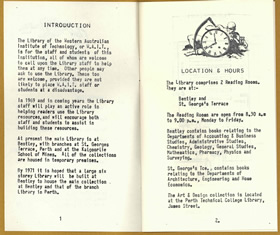 The introductory pages of the Library handbook for 1969 described the various locations of the collections and reading rooms at that time.
The introductory pages of the Library handbook for 1969 described the various locations of the collections and reading rooms at that time.
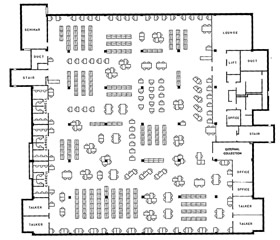 Floor plan of level four in 1972 showing the layout of the collection and client areas.
Floor plan of level four in 1972 showing the layout of the collection and client areas.
There were a number of areas designated 'talker', a seminar room, carrels, offices, a lounge area and the external collection on this level.
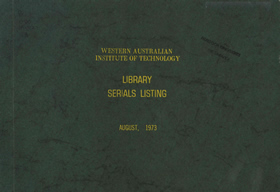 Cover of the printed volume listing all of the journals held by WAIT Library in 1973.
Cover of the printed volume listing all of the journals held by WAIT Library in 1973.
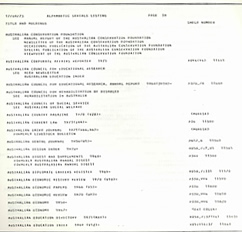 A page from the WAIT serials listing, 1973.
A page from the WAIT serials listing, 1973.
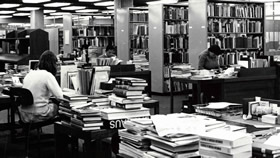 Acquisitions staff processing books in the 1970s.
Acquisitions staff processing books in the 1970s.